Something Old, Something New, Something Borrowed, Something Blue

Something/Someone Old

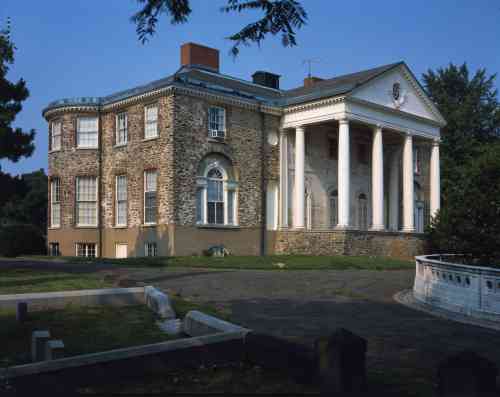
This is the Hamilton mansion, an eighteenth-century house in West Philadelphia. It was originally a 250-acre tract purchased in 1735 by lawyer Andrew Hamilton. Andrew Hamilton was a famous Philadelphia lawyer, originally from Scotland, who made his name successfully defending printer and publisher Peter Zenger from an accusation of libel. His eloquent defense concluded with saying that the press has "a liberty both of exposing and opposing tyrannical power by speaking and writing truth." As far as I know, he bears no relation to the even more famous Alexander Hamilton.
Six years later, Andrew Hamilton died. His son, also named Andrew, inherited, but only lasted six years more before he died in 1747. However, by that time he had increased the holdings to 300 acres, which he left to his son, William.
What William built on his family lands was one of the greatest architectural achievements in eighteenth-century America, a Georgian-style mansion with a two-storied portico overlooking the Schulykill River. It had 16 rooms, a carriage house, greenhouse, and hot houses. Unfortunately, after William died, the land was in high demand; the area surrounding his estate was becoming a suburb.
After Hamilton died in 1813, his heirs sold off much of the Woodlands estate for institutional and residential development. By the first quarter of the 19th century, the West Philadelphia district was becoming a fashionable suburb. In order to save the core of Hamilton's estate, in 1840,[4] The Woodlands Cemetery Company of Philadelphia purchased the last 92 acres (37 ha), which included the mansion, carriage house, greenhouse and hot houses, as well as extensive plantings.
https://en.wikipedia.org/wiki/The_Woodlands_(Philadelphia)
That explains (partly) why I lived almost on top of Hamilton's old estate, going to the University of Pennsylvania (which received most of its lands from him as a gift), and writing my dissertation on, among other things, eighteenth-century botany, without ever knowing about him or visiting the estate; it was in the middle of a cemetery, and, my family living elsewhere, I had no need to go to a Philadelphia cemetery. You'd think somebody would have mentioned it to me, though.
Something New


As always, my "new" things aren't that new, but at least this one is fewer than ten years old. In 2013, Elizabeth Gilbert, famous for her memoir and travelogue Eat Pray Love, published The Signature of All Things, a historical novel set in the late eighteenth century and early nineteenth centuries. Her inspiration for the house where much of the novel is set, White Acre, came from William Hamilton's The Woodlands.
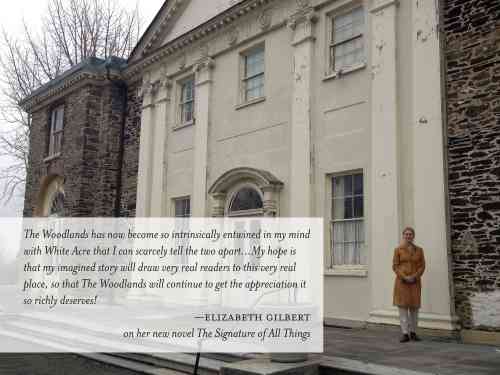
Gilbert's story centers around Alma, the daughter of Henry Whittaker. Whittaker grew up in poverty but managed to cheat, steal, and trade on his father's botanical knowledge and position as a fruit tree man to George III. Using these means, he becomes a botanical and pharmaceutical giant with a worldwide business and a large fortune. He settles in the New World, building a mansion in Philadelphia, and naming it, eponymously and rather egotistically, White Acre.
Alma is born into a world of botany, wealth, and strict discipline (mostly coming from her severe Dutch mother). Her story takes her, eventually, as far afield as Holland and Tahiti. This book is a bildungsroman, a novel focused on the development of the hero, and basically, you're travelling on Alma's shoulder while she tries to make sense of her early nineteenth-century world. Her search for meaning is inextricably wound up with the philosophical debates of the time, and presages later philosophical and scientific developments.
I've been reading this book lately, and I haven't finished it yet, but it's inspiring me, all right--though not, probably, in a direction the author intended. I will have to finish it before I come to any conclusions, so no spoilers, please, if any of you have read the book past the point where Alma arrives in Holland. I don't expect any big plot twists or reversals are waiting for me, but if they are, I want to encounter them in the ignorance a novelist has the right to expect of her readers.
It's a very well-written book, and one which certainly challenges the mind.
Something Borrowed
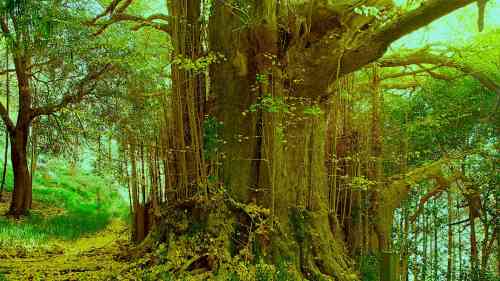
William Hamilton was an active botanist, holding more than 10,000 species of plants in his greenhouses and estate plantings. These included the first specimens introduced into America of the Ginkgo biloba, Paper Mulberry, Sycamore Maple, Ailanthus, Caucasian Zelkova, and Lombardy Poplar.
https://en.wikipedia.org/wiki/The_Woodlands_(Philadelphia)
The ginkgo biloba tree is pretty amazing. It's "borrowed" for us because it is native to China. But I really should have put it under "something old." Ginkgo is unbelievably old!
Ginkgo biloba, commonly known as ginkgo or gingko[4] (both pronounced /ˈɡɪŋkoʊ/), also known as the maidenhair tree,[5] is the only living species in the division Ginkgophyta, all others being extinct. It is a very old species, with some fossils dating back 270 million years.
270 *million* years? Primates hadn't even evolved 270 million years ago!
Ginkgos are large trees, normally reaching a height of 20–35 m (66–115 ft), with some specimens in China being over 50 m (160 ft). The tree has an angular crown and long, somewhat erratic branches, and is usually deep rooted and resistant to wind and snow damage. Young trees are often tall and slender, and sparsely branched; the crown becomes broader as the tree ages. During autumn, the leaves turn a bright yellow, then fall, sometimes within a short space of time (one to 15 days). A combination of resistance to disease, insect-resistant wood and the ability to form aerial roots and sprouts makes ginkgos long-lived, with some specimens claimed to be more than 2,500 years old.
Apparently one of the reasons ginkgo is so good at survival is that it has multiple ways to reproduce--and, in fact, reproduction is one of its reactions to its environment being disturbed:
Accordingly, ginkgo retains a prodigious capacity for vegetative growth. It is capable of sprouting from embedded buds near the base of the trunk (lignotubers, or basal chichi) in response to disturbances, such as soil erosion. Old individuals are also capable of producing aerial roots on the undersides of large branches in response to disturbances such as crown damage; these roots can lead to successful clonal reproduction upon contacting the soil. These strategies are evidently important in the persistence of ginkgo; in a survey of the "semiwild" stands remaining in Tianmushan, 40% of the specimens surveyed were multistemmed, and few saplings were present.
There have been claims that ginkgo can help with memory function and sharpness of mind. Apparently studies on the topic show mixed results.
They have leaves unlike all other leaves on the planet:
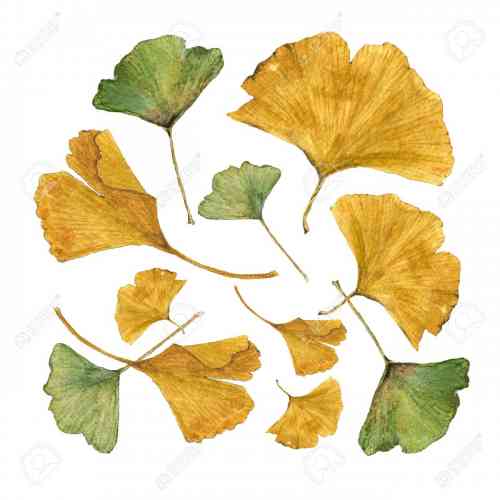
The leaves are unique among seed plants, being fan-shaped with veins radiating out into the leaf blade, sometimes bifurcating (splitting), but never anastomosing to form a network.[11] Two veins enter the leaf blade at the base and fork repeatedly in two; this is known as dichotomous venation. The leaves are usually 5–10 cm (2.0–3.9 in), but sometimes up to 15 cm (5.9 in) long. The old popular name "maidenhair tree" is because the leaves resemble some of the pinnae of the maidenhair fern, Adiantum capillus-veneris.
Something Blue

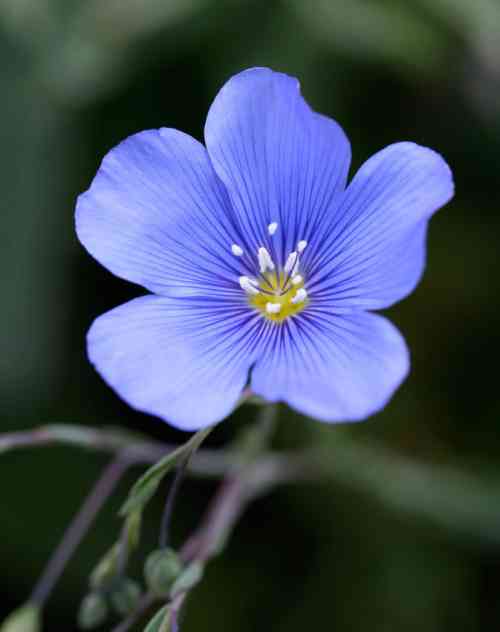
William Hamilton also collected seeds and cuttings from Lewis and Clark's expedition.
Hamilton’s plant collection was vast, and he boasted that “there was not a rare plant in Europe, Asia, Africa, from China and the islands in the South Sea, of which has had any account, which he had not procured.” He was referring to a collection that could only have been amassed through access to a large network of botanists and nurserymen. The network’s local origins lay in the endeavors of James Logan, John Bartram, and Bartram’s English collaborator Peter Collinson. Hamilton’s connections to the new nation’s top political leaders--Washington, Madison, and Jefferson--among others, their similar socioeconomic positions, and their mutual interests in botany and estate development, resulted in his successful lobby to receive seeds sent by Lewis and Clark to the government during their exploratory trip to the Pacific in 1804-1806.
http://woodlandsphila.org/hamiltons-landscape
It's far from impossible that his collection contained the blue flax named after Meriwether Lewis, linum lewisii, collected by the famous expedition (though not, possibly, by Lewis himself) in July, 1806:
Lewis's blue flax, Linum lewisii, was collected on July 9, 1806 in Montana. It is not known for certain who collected the specimen that is housed in the Lewis & Clark Herbarium in Philadelphia. It could have been Meriwether Lewis, who was traveling along the Sun River from Lewis & Clark County into Cascade County, or William Clark, who was at Camp Fortunate in Beaverhead County. Lewis's journal entry for the day says nothing of blue flax, but does talk about the rain and cold, "we then proceeded and it rained without intermission wet us to the skin the day continuing rainy and cold " The preserved specimen in the Lewis & Clark Herbarium appears to be in good shape and has a partially opened flower. Blue flax flowers don't remain on the plant for long, and rain is not a good time to collect blue flax. For these and other reasons, some scholars believe that the blue flax specimen was collected by Captain Clark, who was at Camp Fortunate enjoying a relaxing and pleasant day. Either explorer could have collected Lewis's blue flax and we will never know for sure. At any rate, it was named for Meriwether Lewis by Frederick Pursh, who described the plant in his 1814 Flora Americae Septentrionalis or Flora of North America. Pursh attached a label to the specimen that reads, "Perennial Flax. Valleys of the Rocky mountains. July 9th 1806." This Lewis and Clark specimen is one of a group that was feared lost but was fortunately relocated in 1896 at the American Philosophical Society and subsequently placed on permanent loan to the Academy of Natural Sciences.
http://fwp.mt.gov/education/youth/lewisAndClark/plants/flax.html
It's also known as blue flax and prairie flax, and is native to western North America from Alaska south to Baja California, and from the Pacific Coast east to the Mississippi River.
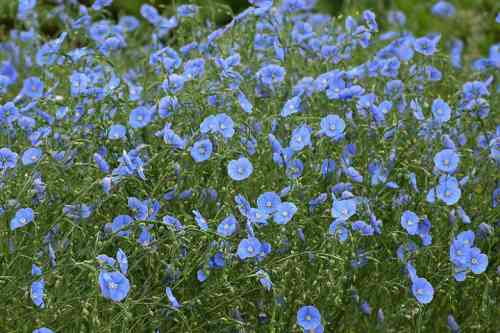
How are you all today?


Comments
Hola CStMS! :-)
Hope you and all is well in your neck of central FL. We are fine down here on the east side.
 I have voted and ballot confirmed received and counted. Set to go in November. Enjoyed your OT. Speaking of Botany and the Hamiltons, have you ever been down to Thomas Edison's place in Ft. Myers? He, too, was fascinated with the plant world, and his small estate is a fascinating display of various bushes, flowers, trees, etc. The road leading up to his place is well known for its border of Royal Palms. The praise is accurate. They are majestic and beautiful. Your Gilbert read reminded me of an excellent commercial historical novel I recently finished. It's called Skeletons at the Feast by Chris Bohjalian. It's the story of German farmers, a German Jew, and a Scottish POW escaping Poland during the end of the Second World War. The author did his research, and how! It's brutal but brilliantly done, and the psychological portraits are nothing short of amazing. Anywho, this is getting wordy. LOL. Rec'd!!
I have voted and ballot confirmed received and counted. Set to go in November. Enjoyed your OT. Speaking of Botany and the Hamiltons, have you ever been down to Thomas Edison's place in Ft. Myers? He, too, was fascinated with the plant world, and his small estate is a fascinating display of various bushes, flowers, trees, etc. The road leading up to his place is well known for its border of Royal Palms. The praise is accurate. They are majestic and beautiful. Your Gilbert read reminded me of an excellent commercial historical novel I recently finished. It's called Skeletons at the Feast by Chris Bohjalian. It's the story of German farmers, a German Jew, and a Scottish POW escaping Poland during the end of the Second World War. The author did his research, and how! It's brutal but brilliantly done, and the psychological portraits are nothing short of amazing. Anywho, this is getting wordy. LOL. Rec'd!!
Inner and Outer Space: the Final Frontiers.
Hey, orlbucfan!
Everything going as well here as it can, under the circumstances. No, I don't think I've been to Edison's Florida estate. I'd love to. I wonder if it's safe? By which I mean, of course, safe-ish. Outdoor things, like gardens and parks, are kind of in a gray area for me.
I try to sit hard on my cabin fever, which has gotten much worse since we've been in our own extreme season. It took me a long time to realize that summer is for Florida what winter is for the North. The weather gets extreme and we all go inside. The only difference is that, if you immerse yourself in water, you can be outside in August in FL, which, polar bear clubs notwithstanding, does not really help in February in Pennsylvania, or New York, or Massachusetts.
You never need to worry about being overly wordy in my OT--I'm always glad to "see" you. And I could use another good book recommendation. I've gotten so far ahead of my mom in the Marjorie Allingham mystery series with her detective, Albert Campion, that I'm taking a break from it. And I'm not far from the end of The Signature of All Things.
"More for Gore or the son of a drug lord--None of the above, fuck it, cut the cord."
--Zack de la Rocha
"I tell you I'll have nothing to do with the place...The roof of that hall is made of bones."
-- Fiver
BTW, kudos for your marvelous sig!
"More for Gore or the son of a drug lord--None of the above, fuck it, cut the cord."
--Zack de la Rocha
"I tell you I'll have nothing to do with the place...The roof of that hall is made of bones."
-- Fiver
good morning...
enjoyed your historical botanical journey today.
If you're planting a ginko, I think you will prefer a male tree.
https://www.nytimes.com/2015/11/01/nyregion/the-female-ginkgo-trees-acri...
In Fort Payne where I taught for many years the old city park had some large old ginko trees.
Hope all is well with you and yours.
“Until justice rolls down like water and righteousness like a mighty stream.”
Wow. Thanks for the heads-up.
I would just as soon not have that in my yard. Good on the gingko, though, for its amazing capacity for survival (including having stinky fruit). Good on the Chinese, too, who didn't just back away and go "Man, that smells! Gross!" but instead figured out you could use it medicinally.
"More for Gore or the son of a drug lord--None of the above, fuck it, cut the cord."
--Zack de la Rocha
"I tell you I'll have nothing to do with the place...The roof of that hall is made of bones."
-- Fiver
In my era New York had a lot of gingko street trees
They do well in the city air as for example along the south edge of Central Park and in the Village.
I remember being told later about their unique "no central midrib." They turn a spellbinding golden color in fall.
Good morning, everybody!
"More for Gore or the son of a drug lord--None of the above, fuck it, cut the cord."
--Zack de la Rocha
"I tell you I'll have nothing to do with the place...The roof of that hall is made of bones."
-- Fiver
Good morning, everyone!
Just a few random things...
It occurs to me that Biden was the candidate selected to beat Sanders. With the threat of significant change beaten back, Harris was selected as the candidate who will actually be running against Trump while Biden mostly hides in his basement.
National Weather Service issues America’s first-ever warning for a fire tornado
All right, who has "firenado" on your 2020 disaster bingo card?
Greenland’s ice sheet has melted past the point of no return
I didn't think that was in doubt, but more peer-reviewed papers help establish consensus.
EDIT: oh, for those not following closely, a full Greenland melt out would raise sea levels about 6 meters.
"The greatest shortcoming of the human race is our inability to understand the exponential function." -- Albert Bartlett
"A species that is hurtling toward extinction has no business promoting slow incremental change." -- Caitlin Johnstone
It's funny how something I know already
can be so horribly depressing.
This defines my politics in a way that most people over 40 can't seem to understand. Even though I'm over 50. I don't know what makes those of us over 50 who get it different from the legions who don't.
I guess it's where we get our news from.
"More for Gore or the son of a drug lord--None of the above, fuck it, cut the cord."
--Zack de la Rocha
"I tell you I'll have nothing to do with the place...The roof of that hall is made of bones."
-- Fiver
It's also odd to think of Biden being selected
as the candidate to beat Sanders, since he has nothing going for him except his association with Obama--well, that and the media-constructed idea of him as a lovable, gaffe-ridden, kindly uncle with a big smile. Actually, they're booking him exactly the way they booked Reagan, but with an aroma of working-class origins and, of course, the association with Obama to make him, and the meme they're using, look more "left."
"More for Gore or the son of a drug lord--None of the above, fuck it, cut the cord."
--Zack de la Rocha
"I tell you I'll have nothing to do with the place...The roof of that hall is made of bones."
-- Fiver
Biden wasn't their first choice
of course. We all were watching it unfold. They tried everyone else first, Harris didn't make it to Iowa. Biden was the absolute last gasp and it was enough. Then Covid hit and the big-rally, knock-on-doors type of campaign Sanders relied upon was no longer possible. Biden had the name recognition and establishment support and could effectively campaign from his basement, Sanders could not.
The role of the VP candidate is to be the attack dog, and Harris will be the public face of the campaign attacking both Trump and Pence, struggling for control of the daily news cycle. They'll wake Biden up from his nap once a week for a 5 minute interview or something.
"The greatest shortcoming of the human race is our inability to understand the exponential function." -- Albert Bartlett
"A species that is hurtling toward extinction has no business promoting slow incremental change." -- Caitlin Johnstone
Bigass tornado ripped up Delaware during Isaias
but unfortunately it didn't target Joe's Bunker. Drat.
There is no justice. There can be no peace.
Good moning CSMS et. al. Thanks for the OT, the info
on Hamilton and Ginko, plus botany an thng botannical. Was never too much into botany in my younger days, but became more interested, to a degree, as I got older. Rain forests have a lot of interesting stuff, including one with a quasi-symbiotic relationship with army ants. I've forgotten what they do for the ants, and the ants defend them. The residents learn them young as not a tree to nap against or under.
The Huntington estate in SoCal has some gardens, I dunno how they compare to others of note, but they do have exemplars of the boojum, a plant so weird that its discoverer named it after thebogeyman from Lewis Carroll's Hunting of the Snark. It's from interior Baja. UC Berkeley's botanical garden has a great collection, well laid out too, should you ever get out this-a-way. It can be a great place to simply hang out. And, should you ever get up to our North Coast, Fort Bragg has one given over largely to plants of the general vicinity, coast and redwood forest, as well as a truly huge selection of types of rhododendrons.
I have to get it in gear to try to check and (do needed inflation on) all the truck and trailer tires before it gets too hot. We've had quire a hat wave for us here, 3 straight days of 100 or better, and slightly muggy too, with overnight thunderstorms last night no less, another rarity, needed rain but now muggy as hell, another rarity. It was already 75 at 6:45 this morning. We're off to the coast for a couple of days tomorrow, so it really needs to be done.
be well and have a good one
That, in its essence, is fascism--ownership of government by an individual, by a group, or by any other controlling private power. -- Franklin D. Roosevelt --
I didn't know that about army ants.
It's nice to know there's a place where they fulfill an important role in the ecological web. I'm not real happy with them in FL, but then, they probably shouldn't be in FL.
UC Berkeley's botanical garden has a great collection, well laid out too, should you ever get out this-a-way. It can be a great place to simply hang out. And, should you ever get up to our North Coast, Fort Bragg has one given over largely to plants of the general vicinity, coast and redwood forest, as well as a truly huge selection of types of rhododendrons.
I would really love to get out that way sometime. Hopefully travel will be possible again while we're all lively and healthy enough to enjoy it!
It is, indeed, too hot. I'm glad that one of the climactic weirdnesses you're getting is nighttime rain--as a Floridian, I can't say enough about the benefits of nighttime rain; like winter rain, it "sticks," hangs around long enough to go down into the aquifer, rather than evaporating in the oven that is our spring/summer/much of fall daytime weather.
"More for Gore or the son of a drug lord--None of the above, fuck it, cut the cord."
--Zack de la Rocha
"I tell you I'll have nothing to do with the place...The roof of that hall is made of bones."
-- Fiver
Ginkgo Petrified Forest has facinated me since visited
as a child
additional photographs
Still yourself, deep water can absorb many disturbances with minimal reaction.
--When the opening appears release yourself.
How fascinating!
I had no idea that existed.
Going to look at the additional photos...
"More for Gore or the son of a drug lord--None of the above, fuck it, cut the cord."
--Zack de la Rocha
"I tell you I'll have nothing to do with the place...The roof of that hall is made of bones."
-- Fiver
The additional pictures are cool.
So, what petrified the gingko was being caught in some ancient lava flow?
"More for Gore or the son of a drug lord--None of the above, fuck it, cut the cord."
--Zack de la Rocha
"I tell you I'll have nothing to do with the place...The roof of that hall is made of bones."
-- Fiver
The Ginko and other trees were too wet
and cooled the molten lava before the tree was burnt. Over the millennia minerals replaced the organic matter to create the petrified wood. The lava cycle of destroying recovered land continued over 100's of thousands of years.
[video:https://youtu.be/1FqnYgNHhF4?t=148]
A little closer to home these trees were burnt during a lava flow over 6,000 years ago at the Lava Cast Forest.
Viewing natural events which destroyed the local enviornment and the recovery process, makes one a believer of virtual permanent damage from some of our modern practices and self created disasters.
Still yourself, deep water can absorb many disturbances with minimal reaction.
--When the opening appears release yourself.
I don't follow...
why would seeing how the Earth has recovered before make you disbelieve in its capacity to do so again?
I admit, we're worse than a lot of previous disasters. But planets live a long time. It seems likely the Earth will be able to create a new biosphere, whether it's full of life forms that can live on plastic and breathe methane, or whether the place eventually gets cleaned up by life forms like that and is able to produce another biosphere like the one we were born into. Neither eventuality seems particularly unlikely to me. It's just that it will happen several million years to late to be any good to me and the beings and places I love.
"More for Gore or the son of a drug lord--None of the above, fuck it, cut the cord."
--Zack de la Rocha
"I tell you I'll have nothing to do with the place...The roof of that hall is made of bones."
-- Fiver
That's the Columbia River in the background